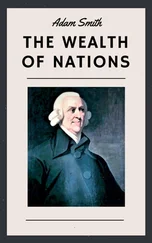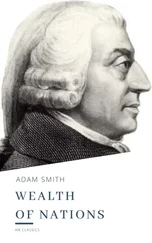Returning to Scotland in 1768, Smith retired to Kirkcaldy and began work on what was to become his most famous book, the Wealth of Nations . His friend Hume complained of his infrequent visits to Edinburgh during this period, but Smith assured him that he was making progress with his studies away from the distractions of the city. Smith travelled to London in 1773 and remained there until 1776, when the Wealth of Nations was published to great acclaim, and was soon followed by a second edition in 1778 and a third, significantly revised edition in 1784. The London of the 1770s was dominated by the dispute with the American colonies, and this context surely shaped Smith’s thinking on international trade (as we will see below). But 1776 also brought a personal blow with the death of Hume. Smith penned a memorial to his friend that was published along with Hume’s own autobiographical essay. He was later to observe that this memorial caused more personal attacks on him than the far more, as he saw it, controversial economic arguments of the Wealth of Nations . There is a certain irony in this as Smith had informed Hume that he was uncomfortable in acting as his literary executor as it would involve publishing the highly controversial, and now classic, Dialogues concerning Natural Religion (1779). The Dialogues is a sustained attack on many of the most popular philosophical arguments for belief in God, and Smith clearly feared this would attract the ire of the religious. In the end, Hume’s essay was published, but to little abuse, while Smith’s memorial produced sustained criticism.
In 1778, Smith’s influential political contacts secured him a position as one of Commissioners of Customs for Scotland and he moved his mother and cousin, Janet Douglas, to Edinburgh and his new residence at Panmure House in the Canongate. By all accounts, Smith was as assiduous in his customs office duties as he had been in his professorial duties. One anecdote from the time tells how he read the list of smuggled goods, realized that he owned many of them himself, and promptly burned these to avoid any accusation of impropriety. He soon became a well-known figure walking up the High Street of Edinburgh from his home to the Customs House opposite St Giles’ Cathedral. One of the very few images we have of Smith is a sketch by the artist John Kay (1742–1826) of him walking up the street holding a posy of flowers to his nose to block out the stench of eighteenth-century Edinburgh. Smith also became an integral part of the Edinburgh social scene and was a leading light in the Oyster Club, a group that met for intellectual debate in a tavern in the Grassmarket. In addition, he hosted Sunday evening dinners for close friends and visitors to the city.
Smith was troubled by poor health in his later years and shaken by the death of his mother in 1784 and by that of his cousin and housekeeper Janet Douglas in 1788. He had never married, and we have almost no evidence of him having any kind of romantic engagement. So his household was gradually reduced to a few loyal servants and the son of his cousin, the young David Douglas, whose education Smith was directing and who would become his heir.
Smith’s late career as a civil servant was complemented by his growing reputation as a policy adviser to government. The success of the Wealth of Nations meant that his ideas were taken seriously at the highest levels. His opinion was sought on the American crisis, on free trade with Ireland, and on the changes to banking regulations. During a trip to London in 1787, many of the leading figures of the government, including the Prime Minister, William Pitt the Younger (1759–1806), attended a dinner in his honour where Smith’s influence on economic policy and free trade was acknowledged. Also in 1787, Smith was elected Rector of Glasgow University. He was particularly delighted by the honour as it reflected the good opinion in which the students at his old university held him. He travelled to Glasgow with his friend the Irish philosopher Edmund Burke (1729–97) for the installation ceremony and gave a talk on the Imitative Arts which he intimated elsewhere was part of an unfinished new book.
By 1790, ill health had set in while Smith was working to produce a final revised edition of The Theory of Moral Sentiments . Although he managed this task, he did not manage to complete unfinished books on jurisprudence and on the arts and asked his executors, the scientist Joseph Black (1728–99) and the geologist James Hutton (1726–97), to help him destroy his papers. On his death, the bulk of Smith’s estate passed to David Douglas, later Lord Reston, an influential judge. Smith left small bequests to his friends and gave significant amounts to charitable causes. All of the evidence we have of his character is that he was a modest and unassuming man who was a loyal friend. Beyond that he seems to have been a very private man who sought to avoid public controversy. Indeed, the care with which he revised his two great books suggests that he wanted them, rather than any details of his personal life, to stand as his reputation to posterity. 2
The Scottish Enlightenment
While the details of Smith’s life give us some insight into the connection between his biography and the content of his ideas, we are limited in what we can build upon this as he was a poor correspondent and ultimately a very private man. We actually gain considerably more insight by examining the intellectual climate in which he lived, the so-called ‘Scottish Enlightenment’. 3
The Scottish Enlightenment was an outpouring of intellectual achievement that occurred during the middle years of the eighteenth century (roughly 1740–90). It forms a subset of the wider phenomenon of the European Enlightenment. The ‘Century of Light’ or ‘Age of Reason’ was a time when many of the features of the modern world came into focus. Ideas of science, academic freedom, progress, and civil liberty became increasingly popular amongst a newly emerging class of public intellectuals. The idea that the darkness of superstition was being replaced by science and reason as part of a movement of cosmopolitan intellectuals, ‘daring to know’, as the philosopher Immanuel Kant (1724–1804) would later describe it, and refusing to accept truths set down by authority, has become central to understanding the intellectual history of the eighteenth century. This idea of thinking for oneself as enlightenment takes a very particular form in Scotland.
At first glance, eighteenth-century Scotland might seem a surprising place for a world-changing flood of science and philosophy. At the time, many considered the country to be a poor, isolated, and war-ridden backwater, more notable for its warring clans, religious fanatics, and wild landscapes than for intellectual achievement. But a combination of historical circumstances, together with a generation of remarkably talented men (and they were all men – it is worth observing that the Scottish Enlightenment, unlike the French Enlightenment, was a remarkably masculine movement), put Scotland at the forefront of the Enlightenment. Some have conjectured that it was precisely a sense of shame at the country’s supposed backwardness that proved to be the spur for this group to pursue Enlightenment in its particular Scottish form.
The history of the time also gives us good reason to understand why the emerging Scottish middle class were so attracted to the idea of Enlightenment. Seventeenth-century Scotland had been torn apart by a series of civil and religious wars. The Church of Scotland (the Kirk) had developed a particularly rigorous form of Presbyterian Calvinism that stressed strict discipline and punished heresy with excommunication and even, in the infamous case of the student Thomas Aikenhead in 1697, with execution. Beyond the religious and political situation, things were not much better. A series of famines had ravaged the country in the 1690s and the failed attempt to found a colony in Central America had virtually bankrupted Scotland’s leading families by 1702. In this setting, the fraught negotiations for the Union of Parliaments in the early years of the century, in which Smith’s father played a minor supporting role, represent the emergence of a social grouping who saw themselves as forward thinking and modernizing.
Читать дальше












